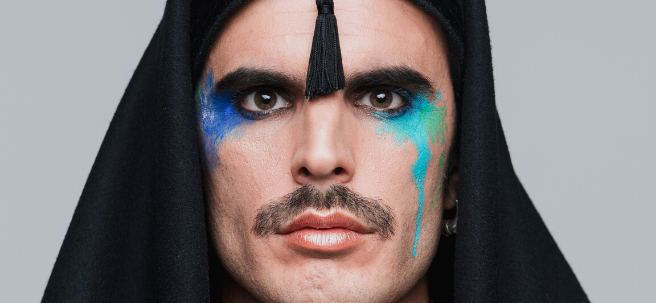
02 de July de 2020
Dinamización rural
02/07/2020. Singer Rodrigo Cuevas, or folklore activist as he likes to call himself, has agreed to speak to the National Rural Network on the occasion of LGBTI (Lesbian, Gay, Transgender, Bisexual, and Intersex) Pride Week.
- Singer Rodrigo Cuevas speaks with the National Rural Network on the occasion of LGBT Pride Week.
- Rodrigo, originally from Oviedo, lives in a town in the municipality of Piloña (Asturias) with 9 inhabitants
 |
Rodrigo welcomes us by phone from his home in a village in the municipality of Piloña (Asturias) and tells us about his rural lifestyle as an artist and homosexual in a village of 9 inhabitants.
RRN: Rodrigo, when and why did you choose to live in a rural area with a professional career that requires you to live on the road?
Rodrigo Cuevas: It was a natural choice for me. Although I'm from Asturias, I lived in rural towns with fewer than 20 inhabitants in Galicia for eight years. And then in Asturias, once I left Oviedo, I lived in villages for twelve years.
RRN: What is life like in a village of 9 inhabitants?
RC: For me, it's wonderful. The coexistence is very good. It's true that these are older people and there are no children, but we all know each other. I always say that in a village, there's a familiarity and a bond of unconditional love between the inhabitants: you love those people for the good and the bad; sometimes you love them and sometimes you even hate them, but you accept the other person just as they are and for who they are.
RRN: You're a well-known LGBTI rights activist. How do you balance this with life in the village?
RC: Personally, I've never had any problems because of my homosexual orientation in the village or in the towns. In fact, I live with my boyfriend and feel very comfortable, so much so that it's where I most enjoy writing. Paradoxically, I had issues with acceptance when I was a child, going to school in Oviedo.
RRN: How do you see the evolution of equality and respect rights in the LGBTI community?
RC: Overall, there's progress, but this is the time when we should least relax, as the threat of cutting them is lurking just around the corner.
RRN: Going back to the village, what are the connections and access to it like?
RC: In my case, I feel very well connected, both by road and by internet connection. The road dates back to 1977, and it's true that there are about nine curves to reach it, but it's accessible. Regarding networks, I belong to the Sestaferia cooperative, which works with neighbors to offer a public service, and through which we share broadband internet for a nominal fee.
RRN: Tell us more about the municipality of Piloña and life there.
RC: Each house has its own garden at the entrance. It supplies me with onions, lettuce, pumpkins, cabbage, and some fruit. I also have chickens and two donkeys for plowing and pulling the cart. The grouping in the council is organized by parishes, which are like a smaller entity within the council. There's one church for every seven villages. What we don't have is a square where children can play.
RRN: You define yourself as a "folk agitator" as well as a singer. To what extent does popular folklore inspire you in your career?
RC: The aesthetics of popular folklore are what inspire me most. I really like traditional Spanish costumes, especially Asturian ones. But I mix it all up. For example, I have 10 pairs of wooden mother-of-pearl clogs made by a village mother-of-pearl keeper. But I wear them both for performances and on the street. They're incredibly comfortable and are still worn in the village, especially on rainy days.









